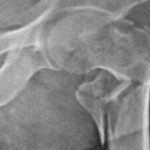1. In this retrospective observational study, there were significant between-hospital and within-hospital variations of cemented implant use in Nova Scotia in patients who suffered a femoral neck fracture and who underwent hip arthroplasty.
Evidence Rating Level: 2 (Good)
Femoral neck fractures are a high priority area for policymakers in Canada due to high prevalence and high mortality rates. Arthroplasty is a common method of treatment, but there is a lack of consensus for the use of cemented versus uncemented implants. A large body of evidence indicates better outcomes with the use of cement, yet there still exist wide variations in the use of cement. Previous studies have concluded that surgical cultures have developed within each culture, explaining the differences in rates. However, this conclusion assumes that there is homogeneity within countries in cement use. This retrospective study aims to measure the variation in the use of cemented implants for the treatment of fractures across Nova Scotia hospitals. Included in this study were patients who underwent primary arthroplasty for femoral neck fracture in Nova Scotia between 2010 and 2020. Rates of cemented implants were computed for each surgeon in each of the five study hospitals. Three measures of variation were calculated for each facility; the extremal quotient (EQ) is the ratio of the highest to the lowest rate. The population-weighted coefficient of variation (WCV) is the standard deviation divided by the mean, and the systematic component of variation (SCV) nets out the random component, meaning the SCV isolates within-surgeon variation. In total, 3787 hip arthroplasties were included in the study, with 2219 (58.6%) having a cemented implant. There was a wide range of cemented implants at the five hospitals included, from 36.6% to 71.1%. At one of the hospitals, surgeons were more than twice as likely to use cement when compared to surgeons at the hospital with the lowest rate of cemented implants. Over time, the rates of cemented implant use increased overall, from 45.7% in 2010/2011 to 70.2% in 2019/2020. With respect to variation, hospital 4 had the largest EQ, where the surgeon with the highest rate of cementing ((98.1%) was 30 times that of the surgeon with the lowest rate (3.2%). The smallest EQ was observed in hospital 5, which was 3.4. Using the SCV, four hospitals were categorized as having “very high” in-between surgeon variation. Overall, the findings from this study suggest that there is a significant between-hospital and between-surgeon variation in cemented implant use. A major limitation of this study is the population, as it is limited to surgeons in Nova Scotia. In addition, unfortunately, age and training were not available for analysis in this study due to confidentiality. This study is an important step for understanding that the division extends down to individual surgeons, rather than being a result of an entire country’s surgical culture. This knowledge, as well as further research to understand the reasoning behind choosing cemented versus uncemented implants, will allow policymakers to effectively encourage the use of cemented implants in the future.
Click to read the study in the Canadian Journal of Surgery
Image: PD
©2022 2 Minute Medicine, Inc. All rights reserved. No works may be reproduced without expressed written consent from 2 Minute Medicine, Inc. Inquire about licensing here. No article should be construed as medical advice and is not intended as such by the authors or by 2 Minute Medicine, Inc.


